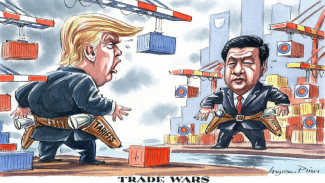
Market Summary 1Q–2025
Tariffs, Tumult, and the Test of Resilience
Markets are reeling today as investors absorbed a seismic shift in U.S. trade policy. The S&P 500 fell 4.8% and the tech-heavy NASDAQ slid 6.0%, marking one of the most turbulent days since the COVID pandemic in 2020. The move followed President Trump’s sweeping tariff announcement, which unveiled a new 10% universal import tax effective April 5, and steep reciprocal tariffs (up to 34% on China and 26% on India) targeting most countries in the world. The average U.S. effective tariff rate now nears 25%, a level not seen since the early 20th century.
This shock has investors recalibrating. Bonds rallied, with the 10-year Treasury yield retreating to 4.05% from 4.78% in mid-January, reflecting a classic flight to safety. The dollar softened as confidence wavered in its role as the global reserve currency, underscoring the complexity of the evolving macro backdrop.
A Stagflationary Cloud
The short-term economic impact if tariffs remain in place is likely to be stagflationary, where rising prices coincide with slowing economic growth. CEO playbooks are reassessing global supply chains, and markets are now bracing for downward revisions to earnings forecasts.
While some view these more aggressive than expected tariffs as an ill-advised pivot toward long-term protectionism - evoking mercantilist ideals that prioritize national self-sufficiency and export dominance over global integration - others (including myself) interpret them as a high-stakes negotiating tactic with room for de-escalation, particularly given the relatively crude tariff formula, which failed to accurately capture the real trade barriers between the U.S. and its trading partners.
Lessons from History
This isn’t the first time trade tensions have rattled markets. Historical episodes from the 1930s Smoot-Hawley tariffs to 2019’s U.S.-China tensions shows that while short-term pain is real, clarity and eventual recalibration often follow. Importantly, past episodes also remind us that markets tend to recover before headlines turn positive. We would note that we’ve already heard reports that some countries have dropped their tariffs on US goods.
Policy Response and the Fed’s Dilemma
One of the big questions now, aside from whether the international response will be retaliation or negotiation, is what the Federal Reserve will do going forward. While inflation risks are rising due to cost-push pressures, growth is set to slow, potentially forcing the Fed into a corner where rate cuts may be required to stabilize the economy, even as inflation expectations creep upward. We believe in the face of a slowing economy and rising unemployment rate, the Fed will choose to lower interest rates to encourage growth given the notion that tariffs should only result in a one-time price increase (i.e. import prices won’t increase 10-25% every year going forward – only once, at the beginning).
What Should Investors Do?
- Stay Diversified: Year-to-date, diversification has helped buffer equity volatility. Bonds, international equities, and many alternatives have played critical roles for a portfolio, and all are up for the year, offsetting US stock declines.
- Remain Long-Term Focused: Market drops, though painful, are part of the investing journey. Most investors are saving for the next 30-50 years, not the next few quarters. Remember that the best return on investments are earned when money is put to work at lower prices. Falling markets present us with better price opportunities.
- Don’t Chase Headlines: As Warren Buffett once noted, over the last nearly 250 years America has weathered multiple wars, recessions, and crises. Declines like today and over the past few weeks are already pricing in a slowdown in the economy. Perfectly timing the market is nearly impossible and usually result in missing the swift rebound. Patient investors have always been rewarded in the end.
- Review and Rebalance: Use volatility as an opportunity. Tax-loss harvesting, rebalancing, and strategic allocation changes can be powerful tools in turbulent times.
While the fog of uncertainty is thick, it eventually lifts. Companies will adapt, consumers will adjust, and negotiations, however tense, are more likely to evolve than to escalate endlessly. Investors should hold fast to the principles of discipline and diversification. History doesn’t repeat, but it does rhyme, and those who stay the course are best positioned to benefit when the dust settles.

